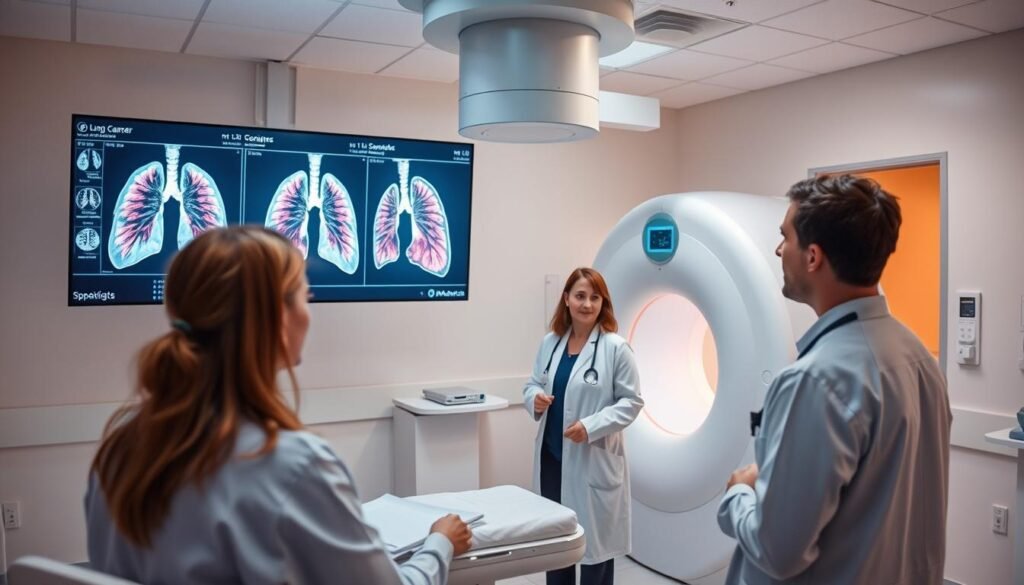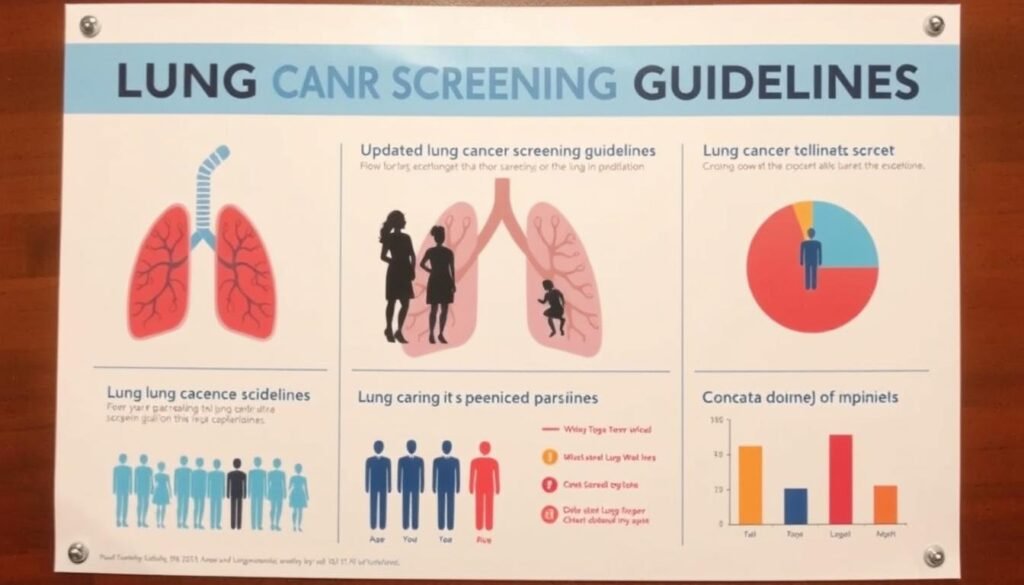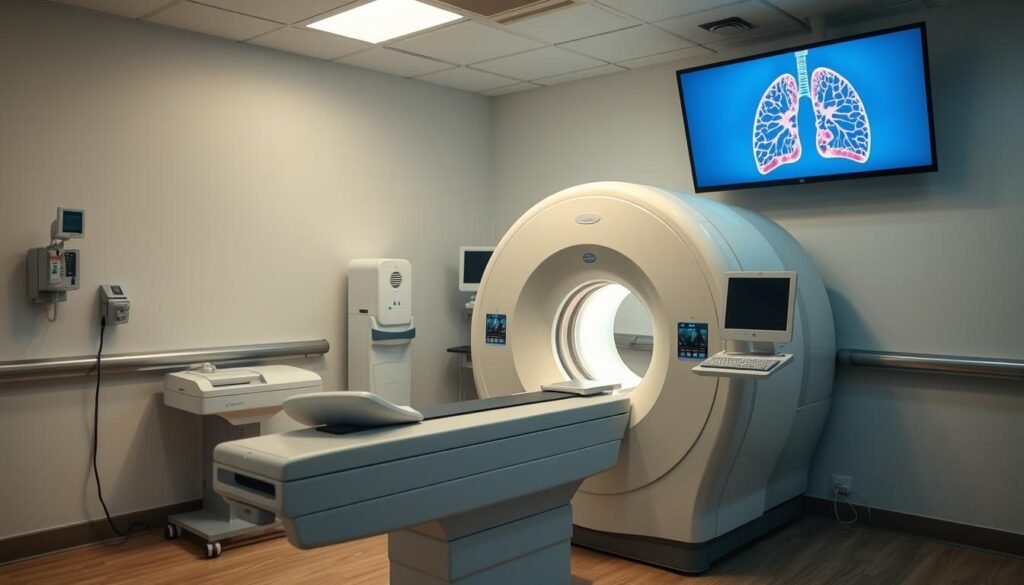Only 5% of people who should get checked for lung cancer actually do it. This is scary because lung cancer kills more people than any other cancer in the U.S. The American Cancer Society updated their rules to help more people catch cancer early, especially those who smoked before. These new rules, which are different from the ones in 2013, say more people need to get checked every year. They make sure the right people, based on recent studies and health data, get these important checks.
Now, even more people who used to smoke can get checked for lung cancer early with these 2023 changes. They suggest using a special kind of x-ray called low-dose computed tomography (LDCT). This is now the main way to look for lung cancer early. It’s a big step in fighting this disease.
Key Takeaways
- The updated lung cancer screening guidelines broaden eligibility significantly for individuals aged 50-80.
- Low-dose CT scans are now the primary method recommended for annual lung cancer screening.
- Five million more Americans are eligible for screening due to the revised smoking history criteria.
- Only a fraction of eligible individuals, about 5%, currently undergo lung cancer screening.
- The updated guidelines reflect a growing recognition of the risks associated with former smokers who quit over 15 years ago.
Understanding Lung Cancer Screening
Lung cancer is the top cause of cancer deaths in the U.S. Each year, more than 235,000 people get diagnosed. This year, over 130,000 might die from it. The goal of lung cancer screening is to find it early. This is especially important for those at high risk, like smokers.
Lung Cancer’s Impact in the United States
Recently, the U.S. has updated how we screen for lung cancer. This helps us find the disease early. Now, 14 million Americans are seen as high risk. They should talk to their doctors about screening. Smoking is the biggest risk factor. It causes most lung cancer cases in both men and women.
Purpose of Lung Cancer Screening
Lung cancer screening aims to find the disease early when it’s easier to treat. Finding it early could greatly increase survival rates after five years. The current guidelines now include more Black Americans and women. This helps fix earlier gaps in who got screened.
Affordable Care Act makes it easier for high-risk people to get screened. This raises awareness about lung cancer. It helps with better handling of the disease.
Overview of the Updated Lung Cancer Screening Guidelines
The lung cancer screening guidelines have been updated. This is big news for catching the disease early and treating it. By making screening more accessible, we can help those at higher risk. Thanks to the new lung cancer screening recommendations, more people can get early help. This could increase their chances of surviving.
Key Recommendations of the 2023 Guidelines
The latest lung cancer screening guidelines suggest yearly screenings. These are for adults aged 50 to 80 who smoke or used to smoke a lot. If you smoked at least 20 pack-years, get checked with a special X-ray called LDCT every year. Former smokers are included, and there’s no need to wait a certain time after quitting. The idea is to find cancer early in more people.
Target Population for Screening
If you’re within the age limit and have a history of heavy smoking, these guidelines are for you. They help doctors focus on who really needs screening. They also start important talks about stopping smoking. If this sounds like you, talk to a doctor about getting screened. It could be really good for your health. For more info, check out the CDC.

| Demographic | Screening Rate |
|---|---|
| Overall (Ages 55-80) | 4.5% |
| Males | 4.5% |
| Females | 4.5% |
| Non-Hispanic White | 4.9% |
| Non-Hispanic Black | 1.7% |
| Hispanic | 0.7% |
| Poverty Level | 3.6% |
| Poverty Level >= 200% | 5.0% |
| Less than High School | 2.3% |
| High School | 7.0% |
| Greater than High School | 3.8% |
| Ages 55-64 | 2.2% |
| Ages 65-80 | 6.6% |
| 30-39 Pack Years | 6.2% |
| 40+ Pack Years | 4.1% |
Changes in Screening Criteria for 2023
The rules for lung cancer screening in 2023 have been updated. These changes make more people eligible for early cancer checks. Age and smoking history changes mean more early screenings and help for at-risk individuals.
Age and Smoking History Revisions
The age to start lung cancer screening is now 50 instead of 55. This means about 5 million more people can get screened each year. This helps find lung cancer early. The smoking history required has also been changed. Now, people with a 20-year pack history can get screened instead of 30. About 14 million people in the U.S. now meet these criteria. They should talk to their doctors about getting screened.
Elimination of ‘Years Since Quitting’ Requirement
The ‘years since quitting’ rule for lung cancer screening has been removed. This is because research shows that people who quit smoking can still get lung cancer. So, the guidelines now say anyone who has smoked can get screened, no matter how long ago they quit. This is to help more people get screened, especially groups who haven’t had enough access in the past, like Black Americans and women. If you’ve smoked before, talk to your doctor about screening. For more on these changes, visit this source.

Importance of Low-Dose CT Scans
Low-dose computed tomography (LDCT) plays a crucial role in detecting lung cancer early. It is a key part of lung cancer screening. LDCT helps doctors find the cancer early, which can lead to better treatment results. Here, we’ll talk more about LDCT and how it helps in lung cancer screening.
What is Low-Dose Computed Tomography?
A low-dose CT scan is a special type of imaging. It uses less radiation than regular CT scans but is still accurate. It’s especially good for checking people who are at high risk for lung cancer, like heavy smokers. Studies show LDCT can catch lung cancer early, which greatly improves chances of survival.
Benefits of Using LDCT for Lung Cancer Screening
There are many reasons to use low-dose CT scans for lung cancer screening:
- Reduced Radiation Exposure: LDCT lowers the radiation patients receive, making it safer.
- High Sensitivity: This method is good at finding small lung nodules early on.
- Lower Mortality Rates: Research shows a 20% drop in lung cancer deaths with LDCT screening.
- Increased Eligibility: More people can now be screened thanks to updated guidelines.
Understanding the value of LDCT in lung cancer screening helps healthcare providers. They can detect the disease early and save more lives.

Comparing 2023 Guidelines with Previous Recommendations
The 2023 guidelines on lung cancer screening are largely different from the 2013 rules. They now include more people and have updates that match the U.S. Preventive Services Task Force’s advice closely. By inviting more individuals for screenings, we’re stepping up efforts to catch lung cancer early.
Changes from the 2013 Guidelines
One notable change is a 62.4% rise in the number of people eligible for lung cancer screening. More women, from 44.1% to 50.1%, can now get screened. Also, the eligibility for Black and Hispanic persons has risen, hitting 9.2% and 4.4% respectively. These updates are important steps toward making lung cancer screening more fair for everyone.
The updates affect many different groups:
| Demographic | 2013 Eligibility (%) | 2023 Eligibility (%) |
|---|---|---|
| Females | 44.1 | 50.1 |
| Black Persons | 6.6 | 9.2 |
| Hispanic Persons | 2.7 | 4.4 |
| Aged 55-64 | 52.6 | 55.8 |
| Urban-Dwellers | 85.9 | 88.3 |
| Unmarried Individuals | 2.5 | 3.4 |
| Non-Retirees | 56.1 | 76.5 |
Alignment with U.S. Preventive Services Task Force Recommendations
The new lung cancer screening rules follow the USPSTF’s advice closely. They suggest yearly screening for those 50 to 80 years old with a *20 pack-year smoking history*. This applies whether they smoke now or have quit in the last 15 years. By adopting these recommendations, we aim to catch lung cancer earlier.
The American Cancer Society thinks these new rules could prevent 21% more lung cancer deaths than before. Currently, only 10% to 15% of those who should get screened do so. The goal is to get more people screened sooner. Health care providers should use the latest guidelines to reach more patients effectively.
Impact on Screening Practices
Recent updates in lung cancer screening mean doctors need to change their ways. These updates make it important to use the new guidelines in everyday care.
How Healthcare Providers Should Adapt
Doctors should talk to patients about lung cancer screening’s pros and cons. It’s key to discuss each person’s smoking history and risk factors. This helps make good choices.
Now, screenings are urged for more people, especially those 50 to 80 with a heavy smoking past. This might get more folks to do yearly check-ups. It could help lower lung cancer deaths.
Importance of Patient Discussions and Counseling
Good talks between doctors and patients are crucial. It helps patients know if they’re ready for screening and what it means. Counseling can make more people follow through with screenings.
Doctors can use resources like the early detection guide to better their talks. This can clear up any wrong ideas about screening for lung cancer.
Potential Challenges and Considerations
The goal of the new lung cancer screening guidelines is to catch the disease early and save lives. Even so, there are hurdles we need to jump over. One major issue is making sure everyone can get screened, no matter their health insurance status or where they live.
Access to Screening and Health Coverage Issues
Some people who need screenings the most can’t get them. They might not have insurance or be near good hospitals. Here’s what stands in their way:
- Financial constraints that make screenings hard to afford.
- Limited programs due to geographic disparities.
- People not knowing how crucial these screenings can be.
We need to fix these barriers. They’re stopping people from getting screened which can save lives.
Risks Associated with Screening
Spotting cancer early is key but screenings have their downsides too. Some challenges include:
- Many screenings show cancer when there isn’t any. A big study found 24% of tests seem positive but 96% are false alarms.
- The worry of having cancer can lead to unneeded medical procedures.
- There’s also the issue of treating slow-growing cancers too fiercely.
It’s crucial we find a balance between the good and the bad of screenings. Overcoming these obstacles means more people get the help they need sooner.
Current Research and Future Directions
The world of lung cancer screening is always changing. We’re focusing on better guidelines and finding cancer early. Research is ongoing to adjust screening processes. This could help more people. Studies show widening screening can majorly cut lung cancer deaths. It’s essential for future work.
Ongoing Studies and Evidence Supporting Guidelines
Low-dose computed tomography (LDCT) can cut lung cancer death rates by 21%. We’re looking into new ways to fight cancer, including:
- Artificial intelligence for risk assessment
- Cell-free DNA liquid biopsy technologies
- Decision support tools to enhance clinical practices
- Behavioral interventions aimed at increasing screening uptake
- Shared decision-making strategies between patients and healthcare providers
We’ve found 17 studies on catching lung cancer early. 9 are still happening, and 8 have ended. This research is key. It will lead to better, easier, and more effective detection ways.
Importance of Smoking Cessation Programs
As we progress in screening, strong smoking stop programs are vital. Quitting smoking is crucial. It lowers lung cancer risk and helps public health. About 85% of lung cancer comes from smoking. Good quitting support makes it more likely for people to stop. This reduces lung cancer numbers.
Health experts push for better screening and studies. But they also say we need to focus on quitting smoking. This not only helps people directly but also reduces lung cancer for everyone.
Conclusion
The American Cancer Society has updated its lung cancer screening guidelines. This is a big step forward in fighting lung cancer. Adults aged 50 to 80 years who smoked for 20 years can now get screened. This includes those who still smoke or have quit recently.
These new guidelines highlight the role of low-dose computed tomography (LDCT). LDCT helps find lung cancer early, when it’s easier to treat. Thanks to these changes, more people can now be screened. This is key because lung cancer is the top cause of cancer deaths in the U.S. Adapting healthcare practices is vital to use these new guidelines well.
As these guidelines start being used in healthcare, it’s important to make sure everyone can access the screening. This is especially true for people from underserved communities. Making sure everyone eligible can get screened is vital for fighting cancer effectively. With ongoing research and efforts to encourage quitting smoking, we hope to reduce deaths from lung cancer in all communities.